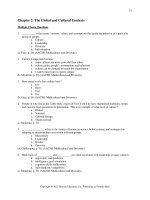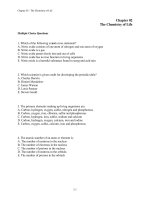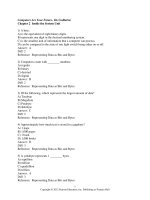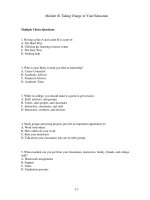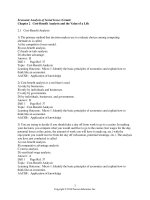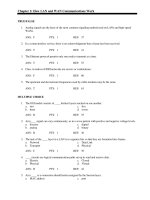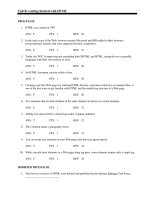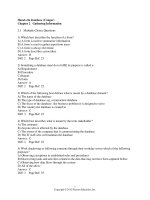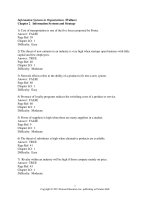HTML5 and CSS3 illustrated complete 1st edition sasha vodnik test bank
Bạn đang xem bản rút gọn của tài liệu. Xem và tải ngay bản đầy đủ của tài liệu tại đây (372.18 KB, 11 trang )
Unit B: Getting Started with HTML
TRUE/FALSE
1. HTML was created in 1997.
ANS: F
PTS: 1
REF: 26
2. In the early years of the Web, browser creators Microsoft and IBM added to their browsers
non-proprietary features that were supported by their competitors.
ANS: F
PTS: 1
REF: 27
3. Today, the W3C is improving and expanding both XHTML and HTML, seeing the two as parallel
languages with their own reasons to exist.
ANS: T
PTS: 1
REF: 28
4. An HTML document consists solely of text.
ANS: T
PTS: 1
REF: 30
5. Creating your first Web pages by entering HTML directly, sometimes referred to as manual labor, is
one of the best ways to get familiar with HTML and the underlying structure of a Web page.
ANS: F
PTS: 1
REF: 30
6. Two elements that are both children of the same element are known as cousin elements.
ANS: F
PTS: 1
REF: 32
7. Adding two spaces before a nested tag makes it appear indented.
ANS: T
PTS: 1
REF: 32
8. The t element marks a paragraph of text.
ANS: F
PTS: 1
REF: 34
9. You can create text elements in your Web page code that user agents ignore.
ANS: T
PTS: 1
REF: 34
10. While you add most elements to a Web page using tag pairs, some elements require only a single tag.
ANS: T
PTS: 1
REF: 38
MODIFIED TRUE/FALSE
1. The first two versions of HTML were defined and published by the Internet Software Task Force.
_________________________
ANS: F, Engineering
PTS: 1
REF: 26
2. HTML 4 codified HTML as a(n) semantic language._________________________
ANS: T
PTS: 1
REF: 26
3. With XHTML, tags must be written in upper case._________________________
ANS: F, lower
PTS: 1
REF: 29
4. The standard name for the main page of a Web site is “main.” _________________________
ANS: F, index
PTS: 1
REF: 30
5. The h1 element represents the highest-level heading on the page._________________________
ANS: T
PTS: 1
REF: 34
6. The title element is part of the document’s body section because the text does not appear in the main
browser window._________________________
ANS: F, head
PTS: 1
REF: 34
7. You can add the appropriate HTML tags to specify the element type for each text item on a Web page.
_________________________
ANS: T
PTS: 1
REF: 34
8. The display of Web pages in HTML5 starts with the standards created by the W5C and the
WHATWG. _________________________
ANS: F, W3C
PTS: 1
REF: 36
9. Instead of affecting text or other elements on the page, one-sided elements generally represent a
specific occurrence of an item or a behavior. _________________________
ANS: T
PTS: 1
REF: 38
10. The char element enables you to pass information about a Web page to user agents that open it.
_________________________
ANS: F, meta
PTS: 1
REF: 39
MULTIPLE CHOICE
1. Web pages are written in ____, which is a standardized format for specifying the structure of a Web
page.
a. CSS
c. HTTP
b. HTML
d. FTP
ANS: B
PTS: 1
2. HTML was created by ____.
a. Microsoft
b. IBM
ANS: D
PTS: 1
REF: 25
c. Tom Bourne
d. Tim Berners-Lee
REF: 26
3. In ____, the World Wide Web Consortium (W3C) was founded to take on the responsibility of
maintaining the HTML’s standards, which it continues to do today.
a. 1990
c. 1998
b. 1994
d. 2002
ANS: B
PTS: 1
REF: 26
4. Cascading Style Sheets (CSS) is a ____ language, meaning that it’s designed for describing the
appearance of items.
a. semantic
c. presentational
b. secure
d. cascading
ANS: C
PTS: 1
REF: 26
5. Many features of previous HTML versions were presentational rather than semantic.W3C designated
these features as ____, meaning that, while these features could still be used, their use was no longer
recommended, and alternatives to their use were available.
a. archived
c. deprecated
b. paused
d. depreciated
ANS: C
PTS: 1
REF: 26
6. ____ grew out of work in the late ‘90s to make HTML comply with the rules of XML in order to
facilitate the interoperation of Web pages with documents coded using other XML-based languages.
a. HTMLX
c. HTML-X
b. XHTML
d. X-HTML
ANS: B
PTS: 1
REF: 28
7. With ____ if authors make minor mistakes, user agents can still use the code by interpreting the code
loosely.
a. XML
c. Both A and B.
b. HTML
d. Neither A nor B.
ANS: B
PTS: 1
REF: 28
8. When a W3C committee voted against supporting HTML, several technology companies formed the
Web Hypertext Application ____ Working Group to begin a process of creating a new HTML
specification.
a. Testing
b. Support
ANS: C
c. Technology
d. Software
PTS: 1
REF: 29
9. While most tags occur in pairs, some tags, known as ____, are used by themselves.
a. solo tags
c. lone tags
b. single tags
d. one-sided tags
ANS: D
10.
PTS: 1
REF: 30
<!DOCTYPE html> creates an element known as the DOCTYPE ____, which lets user agents know
that the document contents are written in HTML.
a. property
c. declaration
b. setting
d. announcement
ANS: C
PTS: 1
REF: 30
11. A tag pair assigns meaning to a Web page ____, which is a specific component of the page, such as a
paragraph or a heading.
a. property
c. object
b. element
d. attribute
ANS: B
PTS: 1
REF: 30
12. You place the ____ tag at the start of the element you are marking and the closing tag at the end.
a. go
c. start
b. opening
d. beginning
ANS: B
PTS: 1
REF: 30
13. When creating a closing tag the opening angle bracket is followed by a(n) ____.
a. ? (question mark)
c. ! (exclamation point)
b. / (slash)
d. # (number symbol)
ANS: B
PTS: 1
REF: 30
14. Both the head and body tag pairs are located within the html tag pair. This situation is known as ____.
a. tagging
c. nesting
b. pairing
d. joining
ANS: C
PTS: 1
15. The ____ is located within the html tag pair.
a. head tag pair
b. body tag pair
ANS: C
PTS: 1
REF: 32
c. Both A and B.
d. Neither A nor B.
REF: 32
16. The ____ element enables you to pass information about a Web page to user agents that open it.
a. pair
c. meta
b. join
d. value
ANS: C
PTS: 1
REF: 32
17. To use an attribute, you provide two pieces of information: an attribute ____ and the value you are
assigning to the attribute.
a. length
b. purpose
ANS: D
c. hyperlink
d. name
PTS: 1
REF: 33
18. In the element <meta charset="utf-8" />, charset is the____.
a. attribute name
c. attribute purpose
b. attribute value
d. attribute tag
ANS: A
PTS: 1
19. It is important to test your code ____.
a. in a variety of popular browsers
b. on multiple operating systems
ANS: C
PTS: 1
REF: 33
c. Both A and B.
d. Neither A nor B.
REF: 36
20. User agents are built around software known as ____ engines that translate Web page elements into
visual, auditory, or tactile representations based on these standards.
a. server
c. sensing
b. rendering
d. creation
ANS: B
PTS: 1
REF: 36
21. The display of Web pages in HTML5 starts with the standards created by the W3C and the
WHATWG. The standards list and describe ____.
a. all the available elements
b. the parameters for how user agents should use available elements
c. Both A and B.
d. Neither A nor B.
ANS: C
PTS: 1
22. The ____ element inserts a line break.
a. lb
b. br
ANS: B
PTS: 1
REF: 36
c. line
d. sp
REF: 38
23. In the figure above, the head element is ____.
a. a child of the html element
c. Both A and B.
b. the parent of the meta element
d. Neither A nor B.
ANS: C
PTS: 1
REF: 32
24. In the figure above, the html element is the ____ element of the meta element.
a. child
c. cousin
b. sibling
d. grandparent
ANS: D
PTS: 1
REF: 32
25. In the figure above, the meta element can be referred to as a ____ element of the html element.
a. grandparent
c. sibling
b. grandchild
d. cousin
ANS: B
PTS: 1
REF: 32
26. In the figure above, the application “Notepad” is a(n) ____.
a. HTML program
c. word processor
b. text editor
d. Web editor
ANS: B
PTS: 1
REF: 31
27. In the figure above, item #1 tells the user agent that the code is written in ____.
a. XHTML
c. XML
b. HTML
d. CSS
ANS: B
PTS: 1
REF: 31
28. In the figure above, item #2 shows a(n) ____.
a. html code pair
c. two-sided codes
b. html tag pair
d. two-sided pairs
ANS: B
PTS: 1
REF: 31
29. In the figure above, item #3 shows a(n) ____ tag.
a. beginning
c. ending
b. closing
d. opening
ANS: D
PTS: 1
REF: 31
30. In the figure above, item #4 shows a(n) ____ tag.
a. beginning
c. ending
b. closing
ANS: B
d. opening
PTS: 1
REF: 31
31. In the figure above, item #1 is pointing to a(n) ____.
a. p element
c. tab
b. h1 element
d. tag
ANS: C
PTS: 1
REF: 37
32. In the figure above, item #1 shows the contents of the ____ element.
a. tag
c. tab
b. title
d. theme
ANS: B
PTS: 1
REF: 37
33. In the figure above, item #2 shows a(n) ____ element.
a. p1
c. t1
b. h1
d. b1
ANS: B
PTS: 1
REF: 37
34. In the figure above, item #3 displays ____ elements as standard text
a. p
c. t
b. h
d. b
ANS: A
PTS: 1
REF: 37
35. In the figure above, if you want the address to show on multiple lines you should use the ____
element.
a. ls
c. br
b. ps
d. sp
ANS: C
PTS: 1
REF: 37
Case-Based Critical Thinking Question
Tom has just started working as an intern for a local radio station. He is responsible for maintaining
the station’s Web site, and is learning HTML as fast as he can.
36. Tom discovers that the correct way to mark the beginning and the end of a Web page is ____.
a. <html> </html>
c. <css> </css>
b. <start> </stop>
d. <meta> </meta>
ANS: A
PTS: 1
REF: 39
TOP: Critical Thinking
37. Tom is announcing a new contest and wants the heading to be as big as possible on the page. To do
this, he should use the ____ element.
a. h1
c. flash1
b. h2
d. flash2
ANS: A
PTS: 1
REF: 39
TOP: Critical Thinking
38. Tom is not sure how to code contents such as title and meta elements. These are coded as ____
elements.
a. body
c. info
b. head
d. comment
ANS: B
PTS: 1
REF: 39
TOP: Critical Thinking
Case-Based Critical Thinking Question
Mary is creating a Web site to document her adoption of a 1-year old little girl from Kazakhstan. Her
friend, Shauna, gives her a list of “rules of thumb” to follow.
39. Shauna tells Mary that in a tag pair, you specify any attributes in the ____ tag.
a. opening
c. Either A or B.
b. closing
d. Neither A nor B.
ANS: A
PTS: 1
REF: 33
TOP: Critical Thinking
40. Shauna also tells Mary that in the element <meta charset="abc-9" />, the entry “abc-9” is the attribute
____.
a. value
c. name
b. title
d. reference
ANS: A
COMPLETION
PTS: 1
REF: 33
TOP: Critical Thinking
1. In the figure above, the section entitled “Encoding” is the ________________ encoding recognized in
the meta tag you entered
ANS: character
PTS: 1
REF: 41
2. In the figure above, the entry in “Doctype” is detected from your DOCTYPE ________________.
ANS: declaration
PTS: 1
REF: 41
3. The publication of HTML 4 in ________________ marked a major turning point in the development
of the language.
ANS: 1997
PTS: 1
REF: 26
4. To create a Web page, you enter text that you want to display on the page along with HTML codes
known as ________________, which specify how a user agent should treat each item in the document.
ANS: tags
PTS: 1
REF: 30
5. The contents of the ________________ section are visible in the main window of a Web browser and
include elements like paragraphs and headings.
ANS: body
PTS: 1
REF: 32
6. The ________________ element specifies text that appears in the title bar of the Web browser opening
the page.
ANS: title
PTS: 1
7.
REF: 34
________________ is an automated process of comparing code you’ve written against the HTML5
coding standards.
ANS: Validation
PTS: 1
REF: 40
MATCHING
Match each letter with the statement that best defines it.
a. attribute
b. charset attribute
c. renders
d. preview
e. comments
1.
2.
3.
4.
5.
Text following the name of the tag in the code you typed
Specifies the character encoding
Involves opening the Web page in one or more user agents and examining the result
Text elements in your Web page code that user agents ignore
The way each browser displays a Web page
1.
2.
3.
4.
5.
ANS:
ANS:
ANS:
ANS:
ANS:
A
B
D
E
C
PTS:
PTS:
PTS:
PTS:
PTS:
1
1
1
1
1
REF:
REF:
REF:
REF:
REF:
32
32
36
34
36
ESSAY
1. What is the difference between a semantic language and a presentation language? Which of these two
types of languages is CSS and HTML4?
ANS:
HTML is a semantic language, meaning its intended use was to indicate the meanings of elements such
as headings and paragraphs in a Web page, but not to tell Web browsers how the elements should
appear.
CSS is a presentational language, meaning that it’s designed for describing the appearance of items.
PTS: 1
REF: 26
TOP: Critical Thinking
2. When can comments be especially helpful? What are some common uses of comments? What is the
syntax of the beginning and end of a comment tag pair.
ANS:
Comments can be especially helpful when you are creating or adding on to a large, complex Web
document or Web site, or when other Web developers will be working with your code—now or in the
future.
Common uses for comments include explaining what a particular section of HTML does or pointing
out the beginning and end of parts of a Web page containing numerous HTML elements.
The comment tag pair begins with <!-- And ends with -->.
PTS: 1
REF: 34
TOP: Critical Thinking
3. Please describe the function each of the following elements serve: html, head, body, meta, and title.
ANS:
The element html marks the beginning and the end of the Web page <html>.
The element head contains elements that are not part of the main Web page <head>.
The element body includes contents that are visible in the main window of a Web browser.
The element meta enables you to pass information about a Web page to user agents that open it.
The element title specifies text that appears in the title bar of the Web browser opening the page.
PTS: 1
REF: 39
TOP: Critical Thinking
